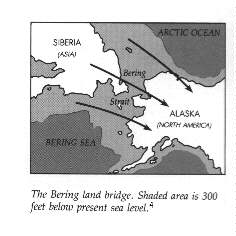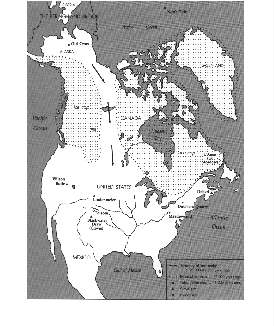|
|
There are numerous theories among the authors of books on Native Americans concerning the origins of the earliest inhabitants of North America. Some of them think that the first inhabitants came across the South Atlantic, or across the South Pacific, others believe that they came through Iceland and Greenland, or across Bering Strait. The most commonly accepted idea of the route of migration of early man is the one via an ancient land bridge across Bering Strait, during the Pleistocene Epoch, or Ice Age. An exact time for this crossing cannot be given, but most of the scientists think that the first Americans must have come to North America some time during the Wisconsin Stage (60000 B. C. - 12000 B. C.).
When the land bridge disappeared is not known. When the first men came is not known. Certain it is, however, that if the land bridge was in existence when the first men came to America, it afforded them an easy approach. If, on the other hand, it had disappeared beneath the waves of the Bering Sea, the men must have crossed on the ice. No on can as yet be positive as to the exact manner of the
crossing.3
Evidence  for this assumption are studies of genetics and other physical characteristics such as the yellowish skin or the dark hair and eyes, which show a certain relationship between Asian people and Native Americans. for this assumption are studies of genetics and other physical characteristics such as the yellowish skin or the dark hair and eyes, which show a certain relationship between Asian people and Native Americans.
Taking into consideration the big distance between Bering Strait and the Southwest of America, one asks oneself how and when these earliest inhabitants of the Northern American continent came to the Southwest. Here again, the opinions of scientists differ, most of the scholars, though, believe that the main route these first Americans took was probably east of the Rocky Mountains, at a time when the ice sheets, which covered the northern parts of North America, began to melt. A precise time cannot be given either, because nobody knows for sure when the ice sheets began to melt. Few scientists still hold the opinion that these ancient Indians came along the Pacific Coast, but, considering the weather conditions and the state of development of the ancient Indians, this route was probably impossible.
The most-favored route is one through the northern, and non-mountainous, portion of Alaska, which turned south on the eastern slopes of the Rocky Mountains, one branch working southward into the Mississippi valley, another going through the western high plains into Mexico, and thence into South America. It was a group of this latter branch which is believed to have swung further west through lower country into the Southwest. A direct passage from Alaska down our west coast is felt to be highly improbable, for the present rugged nature of the country would have made such a route in early prehistoric times nearly impossible.
5

6 The map to the left illustrates the way the first Americans probably took.
We now know the way these ancient Indians probably went, but the time when they arrived in the Southwest is still unknown. Scientists believe that they must have arrived between 13000 B. C. and 9500 B. C. because various archaeological sites, containing material which was dated that old, have been discovered. The time from about 10000 B. C. to 0 A. D. is subdivided into two parts, the Paleo-Indian Period and the Archaic Period. The period starting at about 10000 B. C. is referred to as the Paleo-Indian Period. These Paleo-Indian hunters of the Southwest were probably descendants of the Big Game Hunters, who drifted westwards from the mid-continent prairies when their prey such as mammoths, horses and bison moved westwards in order to profit from the better climatic and biological conditions. These first south-western Big Game Hunters have been named Clovis, after remains found near the town of Clovis, New Mexico. This Clovis Culture were hunters and therefore moved with the animals. The Clovis hunters were succeeded by others, following the same general mobile life, the Folsom Culture. The Folsom hunters, too, were specialised in hunting, while their favoured technique was probably stampeding their prey over a precipice. The Cody Culture, which succeeded the Folsom Culture is the last known culture of the Paleo-Indian Period. This Culture expanded in New Mexico and southern Colorado. Archaeologists distinguish these sub-cultures by examining their projectile points, stone tips attached to a hunting weapon such as a spear or an arrow, and other archaeological dating methods such as the tree ring dating (dendrochronology) and the radiocarbon dating.

7 projectile points from the three major cultures, the Clovis, the Folsom and the Cody cultures.
The other long period starting at about 8000 B. C. is the Archaic Period. The Archaic culture is often referred to as the Desert Culture. The term "desert", though, is misleading because in ancient times the Southwest was no real desert, but there were also grasslands and forests. The Archaic culture includes various distinct groups such as the Cochise culture, the Oshara Culture and the San Diego Pinto Culture. The probably most interesting cultures are the Cochise tradition and the Oshara tradition, as many scientists believe that these cultures were the "real" ancestors of the Anasazi and their neighbouring cultures, the Mogollan and the Hohokam. The Archaic Cultures differ from the Paleo-Indian Cultures in so far as in the Archaic Cultures gathering was predominant. This is only natural because the big animals such as the mammoth, the mastodon and the horned bison had died out, and therefore other sources of food had to be found. Scientists see the evidence for their assumption in the few projectile points as well as in the few animal bones and the existence of grinding stones, which have been found in Archaic sites.
The chief characteristic of the Cochise culture is the extensive use of grinding stones which suggest that the people were primarily dependent on the gathering of wild grains, nuts, roots, and similar foods. The finding of some split and burned animal bones in the sites where they lived indicates that they did hunt, but the lack of projectile points in the earliest period and their scarcity until the most recent phase provides additional evidence that the economy was based on food rather than on hunting.
8
It was also during the Archaic Period that agriculture found its beginnings, as corn, squash and later even beans were cultivated as excavations show. The transition from Archaic to Basketmaker is defined by the first deliberate cultivation of corn, squash and sunflowers, thus starting the transformation of nomads into farmers. With these "innovations" in agriculture the foundation-stone of Anasazi Culture was laid.
Top
|
|

 for this assumption are studies of genetics and other physical characteristics such as the yellowish skin or the dark hair and eyes, which show a certain relationship between Asian people and Native Americans.
for this assumption are studies of genetics and other physical characteristics such as the yellowish skin or the dark hair and eyes, which show a certain relationship between Asian people and Native Americans. 
